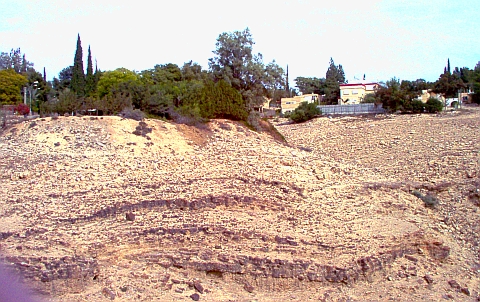 I noticed this disturbing archaeological News on Otagosh, the biblioblog of Gavin Rumney, a one-man encyclopedia of all things to do with Herbert W. Armstrong and the Worldwide Church of God.
I noticed this disturbing archaeological News on Otagosh, the biblioblog of Gavin Rumney, a one-man encyclopedia of all things to do with Herbert W. Armstrong and the Worldwide Church of God.
As a bit of background: Biblical Archaeologist Eilat Mazar announced in October 2008 that the excavation of a tunnel she is supervising in Jerusalem is the tsinnor in the story of King David’s conquest of Jerusalem (2 Samuel 5.6-8; 1 Chronicles 11.4-6). Earlier apologists had identified the tsinnor with a shaft near the Gihon Spring, in the attempt to make simplistic correlations between the Bible and archaeology. But when recent excavations showed that the Gihon Spring site wasn’t used in the tenth century BC (when David is alleged to have lived), the Biblical Archaeologists switched to Mazar’s tunnel, in a further desperate attempt to ‘prove’ the truth of the Bible. After all, Biblical Archaeologists such as Eilat Mazar actually boast that their ‘method’ comprises having a spade in one hand and a Bible in the other. Archaeology then becomes a childish game of joining the dots between the two, rather than a professional attempt to assess the context of the archaeological sites in their own right. No doubt, when problems arise with the correlation between this tunnel and the Bible, Mazar will pick up the Bible again (with her right hand) and use her left hand to dig for some new tunnel.
What Gavin Rumney draws attention to is that Mazar has handed over most of the archaeological dig to uber-fundamentalist Christians from the Church of God cult! That’s like handing over an archaeological dig for the original golden Book of Mormon to the Latter Day Saints, and then announcing that Joseph Smith was telling the truth!!
“A few days after the tunnel entrance was discovered, Mazar set out to excavate the tunnel, assigning Armstrong College students to the task. AC junior John Rambo, 22, from Oklahoma, and graduate Victor Vejil, 24, from Texas, spent nearly two months inside the tunnel, digging using small tools [a Bible?] under artificial light…”
– The Philadelphia Church of God, ‘AC students dig up 10th century B.C. tunnel in Israel’, December 15, 2008
Note: ‘Armstrong College’ is an unaccredited college. Well, it’s more of a fundie training-camp than a ‘college’.
“The tunnel was lost from world view after the Babylonians laid siege to the city in 585 B.C., until AC students stumbled upon it. While describing the student’s contribution, Mazar called the excavation an almost entirely “Armstrong College enterprise.” All the positions related to the tunnel were filled by the student volunteers, except for that of the artist who was responsible for mapping out the tunnel.”
– The Philadelphia Church of God, ‘AC students dig up 10th century B.C. tunnel in Israel’, December 15, 2008
Let’s see… the archaeology is being undertaken by Zionist extremists, the City of David Foundation and Christian Zionist students at an unaccredited college of the Church of God, under the leadership of Eilat Mazar, who holds a Bible in one hand while she digs with the other.
Is it any wonder that the excavation comes up with the oddball proclamations they do, when they involve such one-eyed zealots? Unfortunately, their utterly unfounded proclamations are then uncritically accepted by an ignorant and profit-driven mainstream media, a gullible Christian public, and an equally gullible and also nationalistic Israeli public.
Given such a widespread dissemination of misinformation, it is well worth pointing out the highly suspect groups behind the dig, the routine failure to apply accepted archaeological method, and the completely fanciful and wishful nature of their identifications of archaeological sites with biblical stories.










 In the Boston Globe, September 28, 2008, Jonathan Gottschall
In the Boston Globe, September 28, 2008, Jonathan Gottschall 